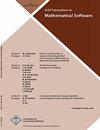Computational Graphs for Matrix Functions
IF 3.2
1区 数学
Q2 COMPUTER SCIENCE, SOFTWARE ENGINEERING
引用次数: 1
Abstract
Many numerical methods for evaluating matrix functions can be naturally viewed as computational graphs. Rephrasing these methods as directed acyclic graphs (DAGs) is a particularly effective approach to study existing techniques, improve them, and eventually derive new ones. The accuracy of these matrix techniques can be characterized by the accuracy of their scalar counterparts, thus designing algorithms for matrix functions can be regarded as a scalar-valued optimization problem. The derivatives needed during the optimization can be calculated automatically by exploiting the structure of the DAG in a fashion analogous to backpropagation. This article describes GraphMatFun.jl, a Julia package that offers the means to generate and manipulate computational graphs, optimize their coefficients, and generate Julia, MATLAB, and C code to evaluate them efficiently at a matrix argument. The software also provides tools to estimate the accuracy of a graph-based algorithm and thus obtain numerically reliable methods. For the exponential, for example, using a particular form (degree-optimal) of polynomials produces implementations that in many cases are cheaper, in terms of computational cost, than the Padé-based techniques typically used in mathematical software. The optimized graphs and the corresponding generated code are available online.矩阵函数的计算图
许多计算矩阵函数的数值方法可以很自然地看作计算图。将这些方法重新表述为有向无环图(dag)是一种特别有效的方法,可以研究现有技术,改进它们,并最终获得新技术。这些矩阵技术的精度可以通过其标量对应的精度来表征,因此设计矩阵函数的算法可以被视为一个标量值优化问题。优化过程中所需的导数可以通过利用DAG的结构以类似于反向传播的方式自动计算。本文描述了GraphMatFun。jl,一个Julia包,它提供了生成和操作计算图的方法,优化它们的系数,并生成Julia、MATLAB和C代码,以便在矩阵参数处有效地对它们进行计算。该软件还提供了工具来估计基于图形的算法的准确性,从而获得数值上可靠的方法。例如,对于指数,使用多项式的特定形式(度最优)产生的实现在许多情况下比数学软件中通常使用的基于pad的技术更便宜(就计算成本而言)。优化的图形和相应的生成代码可在线获得。
本文章由计算机程序翻译,如有差异,请以英文原文为准。
求助全文
约1分钟内获得全文
求助全文
来源期刊

ACM Transactions on Mathematical Software
工程技术-计算机:软件工程
CiteScore
5.00
自引率
3.70%
发文量
50
审稿时长
>12 weeks
期刊介绍:
As a scientific journal, ACM Transactions on Mathematical Software (TOMS) documents the theoretical underpinnings of numeric, symbolic, algebraic, and geometric computing applications. It focuses on analysis and construction of algorithms and programs, and the interaction of programs and architecture. Algorithms documented in TOMS are available as the Collected Algorithms of the ACM at calgo.acm.org.
 求助内容:
求助内容: 应助结果提醒方式:
应助结果提醒方式:


